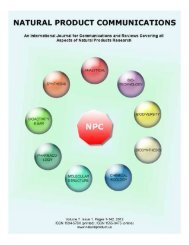This Issue is Dedicated to the Memory of Professor Ivano Morelli
This Issue is Dedicated to the Memory of Professor Ivano Morelli
This Issue is Dedicated to the Memory of Professor Ivano Morelli
Create successful ePaper yourself
Turn your PDF publications into a flip-book with our unique Google optimized e-Paper software.
NPC<br />
Natural Product Communications<br />
New Oxidized 4-Oxo Fatty Acids from<br />
Hygrophorus d<strong>is</strong>coxanthus<br />
2006<br />
Vol. 1<br />
No. 12<br />
1079 - 1084<br />
Gianluca Gilardoni, Marco Clericuzio, Alber<strong>to</strong> Marchetti, Paola Vita Finzi, Giuseppe Zanoni<br />
and Giovanni Vidari*<br />
Dipartimen<strong>to</strong> di Chimica Organica, University <strong>of</strong> Pavia, Via Taramelli 10, 27100 Pavia, Italy<br />
vidari@unipv.it.<br />
Received: July 24 th , 2006; Accepted: August 28 th , 2006<br />
<strong>Dedicated</strong> <strong>to</strong> <strong>the</strong> memory <strong>of</strong> Pr<strong>of</strong>essor <strong>Ivano</strong> <strong>Morelli</strong>.<br />
The results are reported from <strong>the</strong> first investigation <strong>of</strong> <strong>the</strong> secondary metabolites <strong>of</strong> <strong>the</strong> basidiomycete Hygrophorus<br />
d<strong>is</strong>coxanthus (Fr.) Rea. Five new oxidized 4-oxo fatty acids (C 16 , C 18 ) were <strong>is</strong>olated from <strong>the</strong> fruiting bodies and <strong>the</strong>ir<br />
structures establ<strong>is</strong>hed on <strong>the</strong> bas<strong>is</strong> <strong>of</strong> <strong>the</strong>ir spectroscopic data and an ozonolys<strong>is</strong> experiment. Preliminary data indicate a<br />
moderate fungicidal activity, suggesting a possible function <strong>of</strong> <strong>the</strong>se acids as chemical deterrents against mushroom parasites<br />
and preda<strong>to</strong>rs.<br />
Keywords: Hygrophorus d<strong>is</strong>coxanthus, Basidiomycetes, 4-oxo-fatty acids, fungicidal activities.<br />
In a search for new pro<strong>to</strong>type (bioactive) agents from<br />
higher mushrooms (Basidiomycetes) [1], we were<br />
attracted by <strong>the</strong> species Hygrophorus d<strong>is</strong>coxanthus<br />
(Fr.) Rea (fam. Hygrophoraceae) [2]. <strong>Th<strong>is</strong></strong> <strong>is</strong> a<br />
mycorrhizal fungal species, growing solitary,<br />
scattered <strong>to</strong> gregarious in hardwood forests,<br />
particularly in <strong>the</strong> presence <strong>of</strong> Fagus trees, and<br />
fruiting in <strong>the</strong> fall. It <strong>is</strong> easily recognized by a<br />
whit<strong>is</strong>h, v<strong>is</strong>cid cap, with an ochreous-brown border,<br />
hence <strong>the</strong> name, and by <strong>the</strong> widely spaced, cream<br />
colored decurrent gills, turning rust-colored on<br />
rubbing. Our own field observations revealed that <strong>the</strong><br />
fruiting bodies <strong>of</strong> H. d<strong>is</strong>coxanthus are hardly ever<br />
attacked by ei<strong>the</strong>r insects or parasitic fungi.<br />
Fungicidal 4-oxo-2-alkenoic fatty acids were recently<br />
<strong>is</strong>olated from H. eburneus (Bull.: Fr.) Fr. [3], and<br />
related cyclopentenone and cyclopentenedione<br />
derivatives were found in <strong>the</strong> extracts <strong>of</strong> various<br />
Hygrophorus species [4,5]. In addition <strong>to</strong> <strong>the</strong><br />
common fungal sterol ergosterol and derivatives, <strong>the</strong><br />
aroma components <strong>of</strong> various Hygrophorus species<br />
were investigated by GC-MS [6]; a ceramide was<br />
reported from a Chinese Hygrophorus species [7],<br />
malodorous indole derivatives were <strong>is</strong>olated from<br />
H. paupertinus A. H. Smith & Hesler [8], while<br />
muscaflavine and hygrophoric acid were identified as<br />
pigments <strong>of</strong> some Hygrophorus fruiting bodies [9].<br />
No investigation <strong>of</strong> <strong>the</strong> secondary metabolites <strong>of</strong><br />
H. d<strong>is</strong>coxanthus has yet appeared in <strong>the</strong> literature.<br />
Along with <strong>the</strong> ecological observations, th<strong>is</strong><br />
prompted a study <strong>of</strong> <strong>the</strong> chemical constituents <strong>of</strong> th<strong>is</strong><br />
mushroom.<br />
To prevent undesired enzymatic reactions, <strong>the</strong> fresh<br />
fruiting bodies were frozen after collection and<br />
extracted with EtOAc at –20°C. The crude extract<br />
was subsequently partitioned between n-hexane and<br />
MeCN, and <strong>the</strong> residue from <strong>the</strong> more polar layer<br />
was separated by chroma<strong>to</strong>graphy on multiple<br />
reverse-phase C-18 columns <strong>to</strong> give acids 1-5.<br />
Remarkably, <strong>the</strong>se compounds exhibit brownochreous<br />
spots on C-18 TLC-plates sprayed with a<br />
sulfovanillin solution, followed by heating, and are<br />
thus well differentiable from <strong>the</strong> fungal ubiqui<strong>to</strong>us<br />
oleic and linoleic acids, and methyl linoleate, <strong>of</strong><br />
similar chroma<strong>to</strong>graphic polarity, which are detected<br />
as purple spots with <strong>the</strong> same reagent. In addition,<br />
TLC-spots <strong>of</strong> compounds 1 and 2 respond <strong>to</strong> UV<br />
light (fluorescence quenching at 254 nm).







